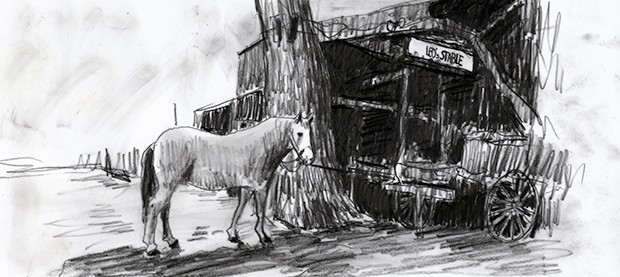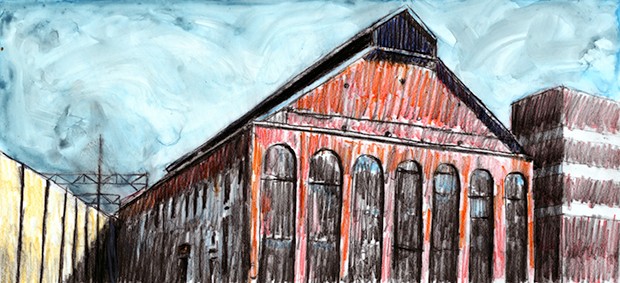The horse palace of Griffintown
In Griffintown / Dans l’Griff | June 7 at 7 a.m.
“It’s a peoples’ history — a Ken Burns–style approach to one of the oldest industrial and working-class neighbourhoods in Montreal,” says artist, filmmaker and alumnus G. Scott MacLeod (MA 13, Art Education).
MacLeod’s master’s thesis is the backbone of an exhibition called In Griffintown / Dans l’Griff, at the Centre d’histoire de Montréal. Using his original drawings, a 17-minute documentary film and videos, the exhibition explores 21 sites on a walking tour of Griffintown.
“The exhibition is about three generations of the Mercier family,” says MacLeod. “It’s the voice of the subjects themselves. Their stories take us down the streets of an industrial sector that has undergone quite the metamorphosis.”
While conveying what life is like for the Merciers, the exhibition highlights local landmarks like Lucky Luke’s horse palace, the Lowney chocolate factory and the site where a Royal Air Force Liberator plane crashed into row houses in 1944.
The complexities of commemoration
Moving Memories - Difficult Histories in Dialogue | June 6, from 1:30 to 3 p.m.
How do you avoid the “competition of victimhood” that can occur in museum planning when two genocides are displayed together? How can they share the same space — literally and figuratively?
Nadine Blumer, a postdoctoral fellow and affiliate with Concordia's Centre for Ethnographic Research and Exhibition in the Aftermath of Violence (CEREV), investigates these questions in Moving Memories - Difficult Histories in Dialogue. This multi-artist exhibition at CEREV intends to shed light on the complexities of commemorating the genocides of the Roma and the Armenians.
“Both the Roma and Armenians have a history of experiencing violence, denial, lack of recognition and ongoing persecution,” says Blumer, who is exhibiting with Hourig Attarian, assistant professor in the Department of Education, and Anique Vered, a visiting academic in the Department of Studio Arts.
“We want to see how we can display and communicate two different stories. How do we tell one history without marginalizing the other?”
The exhibition includes multi-media installations, film and audio. Bloomer’s piece is a replica of Berlin's monument to Roma victims of the Nazi rule.
“The original monument in Berlin is a round, flat pool of water, so we replicated it, then projected images of Roma activists onto the water,” says Bloomer.
Attarian’s installation, “Threading a map, spinning life stories,” integrates oral and video-projected testimonies of second-generation female survivors of the Armenian genocide with a live performance piece. She uses red thread to map Armenian escape routes.
The second component of their Moving Memories exhibition is a Public-Panel-Relay, led by Vered, on Tuesday, June 7.
“We hope the panel will challenge what we mean by an ‘expert,’” says Bloomer.
The city tours
Canal: Walking the Post-Industrial Lachine Canal \ June 5, from 7 to 9 a.m.
La Pointe: L’autre bord de la track / The Other Side of the Tracks | June 6, 7 to 9 a.m.
“I want to get the conference delegates into the wider city, out of traditional spaces and into the neighbourhoods,” says Steven High, who is leading guided tours into regions of southwest Montreal. “Heritage exists in communities.”
High will lead Canal: Walking the Post-Industrial Lachine Canal and La Pointe: L’autre bord de la track / The Other Side of the Tracks, augmented with downloadable audio guides. [Please note: pre-registration is required for these two events.]
“The power of the audio walk is that it’s memory based,” says High. “You’re hearing what was, while seeing what is. They’re not the same thing, so there’s a friction between past and present. You get to think about what’s lost and gained. This often raises political questions.”
High and Hammond will also moderate two “in community” sessions: Teaching/Learning/Living Post-Industrial Ecologies: Roundtable on Concordia’s ‘Right to the City’ Initiative and Walking Post-Industrial Areas.
“These cross-disciplinary sessions will explore the ethical and political stance of researchers and artists who have created memory-based audio or art walks that engage with the post-industrial transformation of our cities,” says High.
“How does in situ listening and curated feeling change the experience of walking through these areas? Does it contribute to or counter the wider aestheticization of rubble into picturesque ruin? What are the underlying politics of these public initiatives?”
Register now for the Association of Critical Heritage Studies Biennial Conference, which runs June 3 to 8, 2016.
 Griffintown Horse Palace (2011) by G. Scott MacLeod
Griffintown Horse Palace (2011) by G. Scott MacLeod
 New City Gas Company of Montreal (2011) by G. Scott MacLeod
New City Gas Company of Montreal (2011) by G. Scott MacLeod


